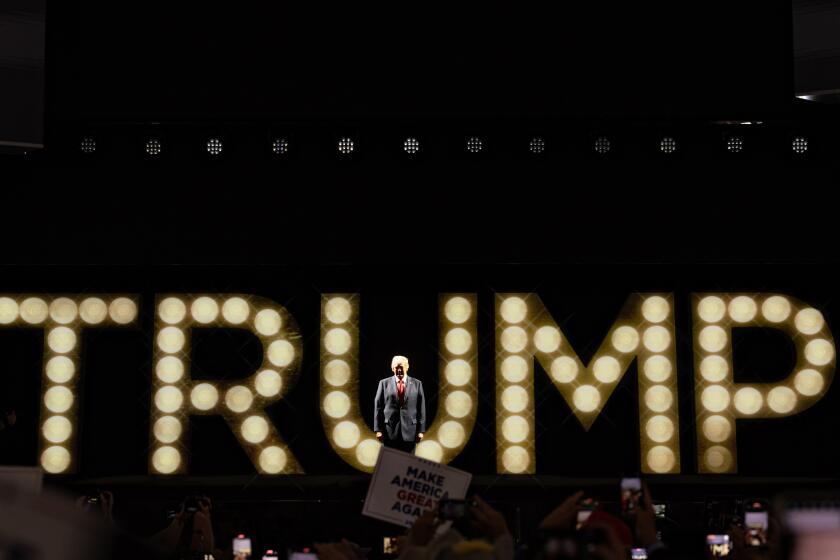Column: I know what a true hillbilly is, and it’s not J.D. Vance

- Share via
From the moment I learned about hillbillies as a child, I was entranced.
Good ol’ boys and girls born high up in the mountains? That’s my parents. People who moved from rural towns to metro areas in search of a better life? Story of both sides of my family. Working class? My upbringing. Lovers of things — food, fashion, music, diction, parties — that polite society ridiculed? Yee-haw! Stubbornly clinging to their ancestral lands and ways? ¡Ajúa!
I learned to love bourbon, bluegrass, “Hee Haw” reruns and Jeff Foxworthy’s “You Might Be a Redneck If ...” series. As an adult, I drove through the small towns of central and eastern Kentucky and Tennessee, feeling at home in areas even my white friends warned wouldn’t take kindly to “my type.” I might not have outwardly resembled the ’billies I met — I’m a cholo nerd, after all — but we got along just fine, because they were my brothers and sisters from another madre.
That’s why I was intrigued when J.D. Vance’s memoir, “Hillbilly Elegy,” was released in 2016. From what I heard about it, the familial dysfunction, generational poverty and inherent fatalism that Vance overcame were similar to the pathologies of my own extended clan. The up-from-bootstraps message he preached in interviews was what my parents had always preached, and what I still subscribe to. Vance’s critique of conspicuous consumption among the poor is something everyone should consider.
But the parallels between the clean-cut Vance and me only went so far. He was a Yale graduate and venture capitalist, while I’m a community college kid who chose a dying profession. He was far removed from his roots, while I experience mine nearly every other weekend at family parties. More importantly, Vance cast himself as an extraordinary exception to his fellow Appalachians, describing ’billies as encased in a toxic amber that kept them from improving their lot and left them embittered with a country that has moved on without them.
My Mexican hillbilly family never had time to whine and mope.
J.D. Vance, the Ohio senator and author of the acclaimed memoir ‘Hillbilly Elegy,’ will be the Republican vice presidential nominee, former President Trump announces.
My parents’ generation found blue-collar jobs, bought homes and are now retired and enjoying the fruits of their blood, sweat and tears. Most of my cousins got white-collar jobs or joined the public sector. Their children are going straight to four-year universities.
We all made it in a society that never gave us a handout and wanted us to fail, embracing it as ours even as we hung on to our rancho traditions. Even Vance expressed admiration for our trajectory, writing in “Hillbilly Elegy” that white Appalachians wallow in pessimism, unlike Latino immigrants, “many of whom suffer unthinkable poverty.”
I never got around to reading all of Vance’s memoir — it seemed like poverty porn for the elite he now belonged to. I did read his stream of essays for liberal publications explaining why working-class whites were so enthralled with Donald Trump, a man he would go on to call a “fraud,” “a moral disaster,” “cultural heroin,” “reprehensible” and a “cynical a—hole” who might turn into “America’s Hitler.” I appreciated that Vance didn’t blame immigration for America’s supposed decline as much as other right-leaning pundits did, and even called out Trump for his rank racism.
What a difference running for office makes. In 2022, Vance sought a U.S. Senate seat as a Trump-worshiping xenophobe. What changed his mind?
Mexicans.

“Are you a racist?” a now-bearded Vance cheerily asked in a commercial released for his campaign. “Do you hate Mexicans?” “The media” maligned “us” with those charges, he said — “us” meaning those who supported Trump’s border wall — and went on to claim that unchecked migration under the Biden administration was “killing Ohioans” with “illegal drugs and Democratic voters pouring into this country.” Vance ended his 30-second spot by blaming the “poison coming across the border” for nearly killing his mother, whose struggles with drug addiction Vance documented in his book and a Netflix film of the same name as his memoir.
The commercial made California Gov. Pete Wilson’s infamous “They Keep Coming” 1994 reelection ad seem as pro-Mexican as a taco truck. Many Latinos immediately ridiculed Vance’s campaign gambit as the woe-is-me blamefest that it was. But it worked: Trump endorsed him, he won, and he has continued his anti-Mexican crusade ever since.
Last year, the senator introduced a bill seeking to establish English as the official national language. He has endorsed the use of American military forces to go after drug cartels in Mexico while opposing amnesty for immigrants illegally in the U.S. and federally funded healthcare for DACA recipients. Last week, Vance supporters received a fundraising plea that called for the deportation of “every single person who invaded our country illegally.”
Now, he is Trump’s choice for vice president.
Members of the Republican Party have gathered in Milwaukee to officially name former President Trump to the 2024 ticket.
Trump has long made clear that he wants nothing but lickspittles surrounding him in a second administration. He also wants someone young enough to implement Trumpism in all branches of American life and government for decades to come. Who better than a 39-year-old white guy from Ohio? Trump is looking toward the future by choosing Vance — but through a lens reflecting the gringo past.
Long considered a bellwether state essential for any successful presidential run, Ohio is also an anomaly. White people, who make up 58% of the U.S. population, are 77% of residents in the Buckeye State. Ohio under-indexes for African Americans and Asian Americans but especially Latinos — we’re nearly 20% of this country’s population but just 5% of Ohioans.
Vance’s job for Trump is to campaign in Rust Belt swing states, arguing for a defense of whiteness against the browning of America. Neither will explicitly admit that’s what they’re doing — how can they be anti-immigrant when Trump is married to an immigrant and Vance’s wife was born to Indian immigrants?
But the proof was visible Monday, on opening night of the GOP convention. Not a single Latino sat in Trump’s VIP section. All three Latinos who spoke propped themselves up, Vance-like, as exemplars of their community and thus worth paying attention to. The most prominent one, Goya Chief Executive Bob Unanue, spent his five minutes trashing open borders and making fun of Vice President Kamala Harris’ first name in Spanish, a joke that fell flat because few in the audience habla español.
Maybe Trump’s advisors think that Vance’s background and life story will appeal to Latinos in swing states like Nevada and Arizona, especially in light of recent polls showing that Latino antipathy against illegal immigration is higher than it’s been in decades.
But part of the bootstrap mentality is not to blame others for your circumstances. And Vance has plenty of blame to go around. In “Hillbilly Elegy,” he faulted Appalachian culture for keeping his people down. He now insists that it’s actually his fellow elites who have destroyed the United States. Mexico, Vance now says, is the reason his mother and too many others became addicted to opioids. There is no concept of personal responsibility in Vance’s worldview — or Trump’s, for that matter.
Vance is a classic example of a convenenciero — someone who goes through life with no principles other than getting ahead, and no loyalty to a community other than his own. Hillbillies of all backgrounds loathe such pendejos, which is why nearly all of my Southern friends ridiculed “Hillbilly Elegy” and warned the liberals enamored with it that they were propping up a false prophet.
Now, Vance has a very good chance of becoming the second-most powerful person in the United States — courtesy of Trump, the undisputed king of false prophets. Heaven help us all.
More to Read
Sign up for Essential California
The most important California stories and recommendations in your inbox every morning.
You may occasionally receive promotional content from the Los Angeles Times.













